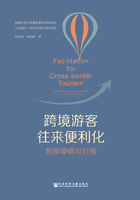
Preface
At present,deepening reform and opening up are the most distinctive themes of the new era.China has stepped into a new stage of a higher level and all-dimensional opening scenario which is represented for the implementation of “the Belt and Road Initiative”,the establishment of a new open economic system,the construction of a free trade zone and even a free trade port.The structure of foreign trade has been continuously transformed and upgraded from goods trade to service trade.Tourism service trade represented by inbound and outbound tourism has always been the most important component of China's service trade,while inbound and outbound tourism represented by cross-border tourists in border areas has always been an important part of the inbound and outbound tourism market.
The Third Plenary Session of the 18th Central Committee of the Communist Party of China proposed to speed up the pace of opening up along the border,to allow border key ports,border cities,and economic cooperation zones to implement special methods and policies in personnel exchanges and tourism.In order to implement the requirements of the Third Plenary Session of the 18th CPC Central Committee,in January 2016,the State Council promulgated “the Several Opinions on Policies and Measures to Support the Development and Opening of Key Areas Along the Border”(Guo Fa〔2015〕No.72).The document clearly put forward to break down institutional barriers,and promulgated policies conducive to promoting cross-border travel between tourists.The document also proposes the establishment of a cross-border tourism cooperation zone and a border tourism pilot zone to achieve the main purpose of supporting pilot projects along key areas in the border areas and exploring new ways and practices that facilitate the facilitation of cross-border tourists.In order to promote the facilitation of cross-border tourists in border areas and the construction of border tourism pilot zones and cross-border tourism cooperation zones,tourism and related departments are actively engaged in actions.At present,the issue of cross-border tourist facilitation has begun to transition from policy requirements to the implementation phase.There is an urgent need for relevant research to guide the practice of facilitating cross-border exchanges between tourists in key areas along the border.
This project focuses on the institutional factors that restrict cross-border tourism in the land border area.These factors include bilateral institutional factors such as bilateral visa agreements,bilateral port management agreements,bilateral transportation agreements,etc.,as well as unilateral institutional factors,such as China's ADS,border tourism management methods,foreign-related certification policies,and the regulations governing cross-border tourism in the other country.The institutional factors affecting tourists' cross-border exchanges involve many countries and departments,including foreign-level diplomatic visas,public security exit and entry management,public security traffic management,transportation,port management,tourism,and related departments of border cities.These institutional barriers are layered and intertwined,just like a large net suppresses the rising demand of the cross-border tourists,which seriously affects the further improvement of the opening up in the border areas,which is inconsistent with the requirements of implementing “the Belt and Road Initiative”,and is not in conformity with the requirements for constructing a comprehensive opening up pattern.
The research group has conducted a lot of research on important cities and key ports along the border in recent years,and conducted field research of same port cities including Ruili,Tengchong,and Xishuangbanna of Yunnan Province,Manchuria and Erenhot of the Inner Mongolia Autonomous region,Dandong of Liaoning Province,and so on.During this period,the group also held extensive discussions with the related departments of border cities,such as tourism,public security,foreign affairs,entry and exit,border defense,customs,transportation,and port management committees,etc..The group has participated in cross-border travel from Dandong Port to North Korea and from Suifenhe Port to Vladivostok,Russia.With the assistance of the national tourism authorities,a survey form was also issued to key cities along the border,which involved the factors affecting cross-border tourists.The tourism or related departments along the border cities carefully filled out the survey.On the basis of the above work,the research team systematically sorted out relevant institutional documents affecting cross-border tourism.
The head of the research team participated in the drafting of the “Several Opinions on Policies and Measures to Support the Development and Opening of Key Areas Along the Border”(Guo Fa〔2015〕No.72),and participated in the design of the policy framework for border tourism pilot zones and cross-border tourism cooperation zones which committed to promote cross-border tourist exchange facilitation.The research team expresses the heartfelt gratitude to the Department of political science and law of the former National Tourism Administration,the Western Development Division of the National Development and Reform Commission,the Entry-exit Administration of Ministry of Public Security,the Ministry of Foreign Affairs,the Port office of the State Council,and the Scientific Research Institute of the Ministry of Transport. Meanwhile,many tourism,entry-exit and port management departments in key cities along the border conducted survey form filling and research cooperation.These cities include Suifenhe and Heihe of Heilongjiang,Yanbian of Jilin,Dandong of Liaoning,Manchuria and Erenhot of Inner Mongolia,Horgos and Altai of Xinjiang,Xishuangbanna and Ruili of Yunnan,Dongxing of Guangxi,and so on.We have to express our sincere gratitude for their active cooperation.